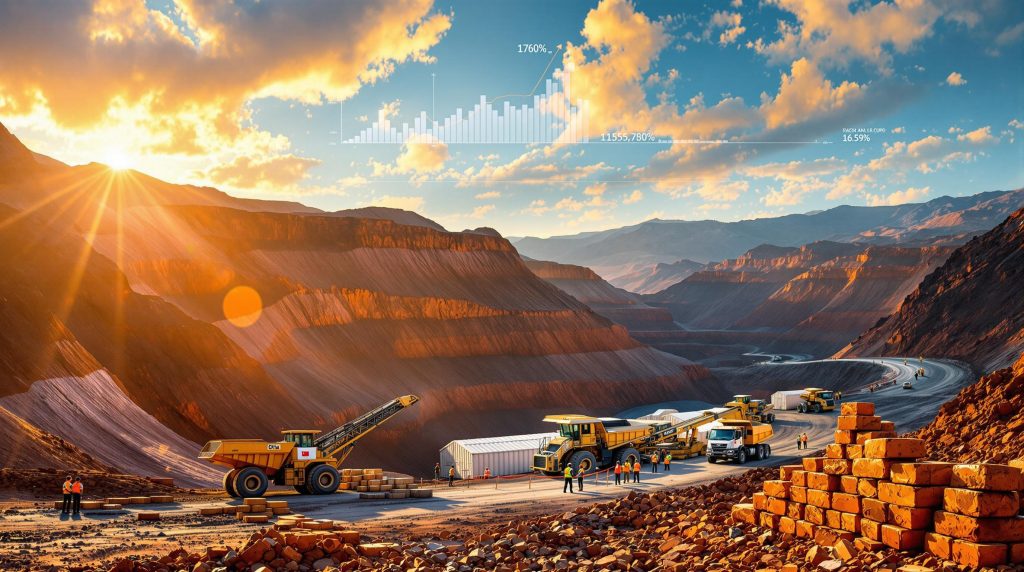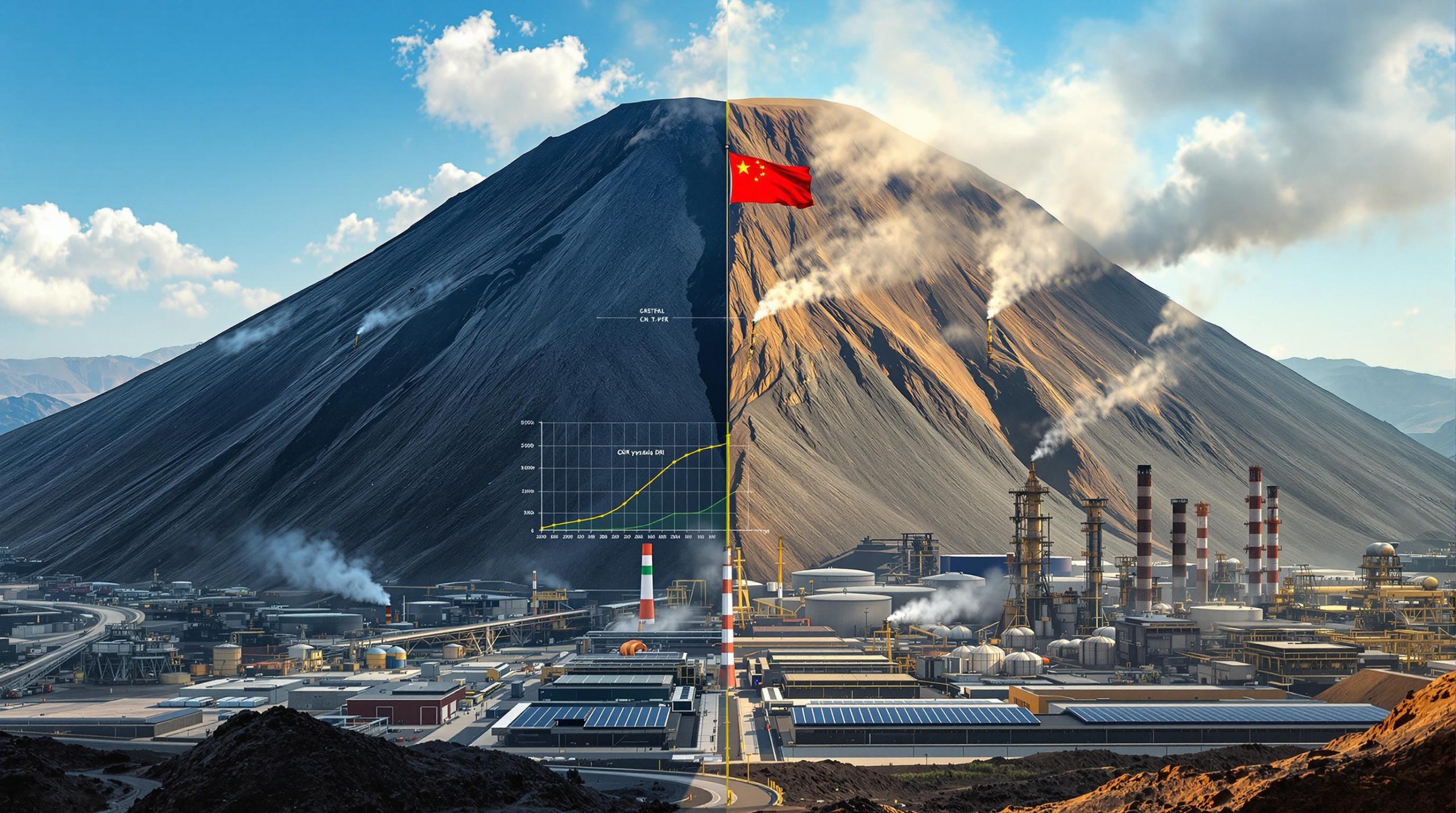MMG's Las Bambas Copper Mine: Political Risks and Operational Challenges
Las Bambas stands as Peru's largest copper mine and the ninth-largest globally, producing approximately 400,000 tonnes of copper annually. This massive operation has become MMG Ltd's crown jewel, generating substantial revenue while facing unique challenges at the intersection of politics, community relations, and global supply chains.
The mine's strategic importance extends beyond MMG's portfolio to play a critical role in global copper markets, particularly as demand rises for renewable energy technologies and electric vehicles. However, this significance comes with complexities that investors and industry observers must understand amid ongoing copper price volatility.
What is the Las Bambas Copper Mine?
Overview of Las Bambas
Las Bambas operates as a world-class copper mining complex situated in the Apurímac region of Peru, approximately 70 kilometers southwest of Cusco. As the ninth-largest copper mine globally, it maintains an impressive annual production capacity of approximately 400,000 tonnes of copper concentrate.
The operation is owned and managed by MMG Ltd., a Chinese mining company listed on the Hong Kong Stock Exchange. Within MMG's diverse portfolio of mining assets, Las Bambas holds the distinction of being both its flagship asset and its most profitable operation, as confirmed by CEO Zhao Jing Ivo in recent statements.
The mine's strategic importance cannot be overstated – it serves as a vital link in the global copper supply forecast, particularly as the world accelerates toward electrification and renewable energy technologies that require substantial copper inputs.
Historical Performance and Production Metrics
Las Bambas' production capacity makes it a significant contributor to both MMG's financial performance and Peru's mining sector. The company's current guidance projects output between 360,000-400,000 tonnes for 2025, reflecting both the mine's capabilities and the operational realities it faces.
The mine's economic impact resonates throughout Peru's economy, generating substantial export revenue, tax contributions, and employment opportunities. Las Bambas has proven to be a tremendous financial engine for MMG, playing a central role in the company's remarkable financial recovery in 2025, when it reported a net income of $340 million for the first half of the year – a dramatic improvement from the $21.1 million reported during the same period the previous year.
This financial performance has not gone unnoticed by investors, with MMG shares rising following the earnings announcement, despite ongoing operational challenges.
How Does Peru's Political Climate Affect Las Bambas?
Upcoming Presidential Election Concerns
The April 2025 presidential election in Peru has been identified as a significant risk factor for Las Bambas operations. CEO Zhao Jing Ivo has explicitly warned about heightened risks during this period, noting that the company "expects a heightened risk of protests around the elections" and emphasizing that "we have to leave some room for contingencies."
This clear acknowledgment from leadership reflects the historical pattern observed in Peru, where electoral cycles often coincide with increased social activism and mining protests in Peru. The political uncertainty that accompanies election periods can amplify existing tensions and create new challenges for mining operations.
For Las Bambas, this electoral risk necessitates proactive planning around inventory management, production scheduling, and community engagement strategies. The company must prepare for potential disruptions while maintaining operational continuity during what could be a volatile period.
History of Political Instability Impact
Peru's complex political landscape has repeatedly affected mining operations throughout the country. Presidential transitions often bring shifts in regulatory approaches, environmental policies, and attitudes toward foreign investment in the mining sector.
Las Bambas has experienced the direct impact of this political instability throughout its operational history. Changes in administration have sometimes resulted in different approaches to mediating community conflicts, with varying levels of government involvement and effectiveness.
For foreign investors like MMG, this political uncertainty represents a significant challenge. The regulatory framework governing mining operations can experience subtle or dramatic shifts depending on electoral outcomes, affecting everything from permitting processes to environmental compliance requirements.
The relationship between Chinese ownership and Peruvian politics adds another layer of complexity, as resource nationalism sometimes becomes a political talking point during campaign periods amid broader US-China trade tensions.
What Social Challenges Threaten Las Bambas Operations?
Ongoing Community Conflicts
Las Bambas continues to face significant challenges from community conflicts that directly impact operations. As recently as July 2025, road blockages disrupted the transportation of semi-processed copper from the mine, creating logistical bottlenecks and inventory management challenges.
According to CEO Zhao, these recent conflicts remain unresolved by government mediation efforts. More concerning for investors and operators, he has indicated that additional protests could materialize in the second half of 2025, suggesting continued operational risks.
These transportation disruptions create cascading effects throughout the operation. When copper concentrate cannot be transported efficiently, storage capacities at the mine site become strained, potentially forcing production slowdowns. The company has reported that it continues working to clear inventory backlogs resulting from these disruptions.
The persistence of these conflicts highlights the complex social dynamics surrounding large-scale mining operations in Peru and the challenges of maintaining what the industry refers to as a "social license to operate."
The 2022 Production Shutdown
The most severe disruption in Las Bambas' recent history occurred in 2022 when protesters entered the mine site and refused to leave, forcing a complete operational shutdown that lasted for months. This unprecedented action represented a significant escalation beyond the more common road blockages.
This extended shutdown had profound financial implications for MMG, dramatically reducing copper output and revenue generation during a period when global copper price insights were strong. The company's comparatively weak financial performance in the year following this disruption underscores the material impact of such social conflicts.
The 2022 shutdown also sent ripples through global copper markets, temporarily removing a significant source of supply and contributing to market volatility. For Peru's mining sector, it raised difficult questions about security, community relations, and the government's ability to mediate complex socio-environmental conflicts.
How Is MMG Managing Community Relations?
Stakeholder Engagement Strategies
Following the devastating 2022 shutdown, MMG has implemented more robust community engagement strategies. CEO Zhao has specifically highlighted the company's efforts to "build a relationship with the local communities, including artisanal miners," crediting these initiatives with preventing similar site occupations.
This focus on artisanal miners represents an important strategic shift. Throughout Peru, tensions between large-scale mining operations and small-scale, often informal miners have created significant conflicts. By explicitly engaging with this stakeholder group, MMG appears to be addressing a root cause of previous tensions.
The company's approach likely includes regular consultation mechanisms, transparent communication channels, and formal agreements that establish clear boundaries and expectations. While specific program details aren't publicly disclosed, the CEO's statements suggest a structured and ongoing engagement process rather than ad hoc responses to crises.
Conflict Resolution Approaches
MMG's evolving approach to conflict resolution at Las Bambas likely combines direct negotiation with community representatives, government-facilitated mediation, and proactive problem-solving mechanisms.
The company appears to have recognized that prevention is less costly than crisis management, both financially and reputationally. By engaging communities as stakeholders rather than obstacles, MMG has attempted to shift the dynamics that previously led to disruptive protests.
However, the ongoing transportation disruptions suggest that these approaches have not fully resolved all community concerns. The complex web of stakeholders surrounding Las Bambas – including multiple communities, local governments, national authorities, and various interest groups – makes comprehensive conflict resolution extraordinarily challenging.
The effectiveness of these approaches will likely be tested during the upcoming election period when tensions typically escalate and political opportunism can complicate mining-community relations.
What Are the Financial Implications of Las Bambas Disruptions?
Impact on MMG's Performance
The financial contrast between periods of disruption and smooth operation at Las Bambas is stark. MMG reported a net income of $340 million for the first half of 2025, compared to just $21.1 million in the previous year – a more than fifteen-fold increase that highlights both Las Bambas' profit potential and the severe impact of operational disruptions.
This dramatic recovery drove share price gains as investors recognized the mine's fundamental profitability when operating consistently. However, this financial performance remains vulnerable to the operational risks posed by community conflicts and political uncertainty.
The costs associated with production interruptions extend beyond lost revenue. Additional expenses include inventory management, security measures, community negotiations, and lost economies of scale when production levels fluctuate. The company must also manage investor confidence, which can affect capital costs and market valuation.
Looking forward, MMG's revenue forecasts must incorporate potential disruptions, particularly around the April 2025 election period. This uncertainty creates planning challenges for the company and valuation difficulties for investors attempting to model future cash flows.
Global Copper Market Effects
As the ninth-largest copper mine globally, Las Bambas' production status has measurable impacts on worldwide copper supply. When the mine experiences significant disruptions, like the months-long shutdown in 2022, the resulting supply shortfall can contribute to price volatility in global copper markets.
The copper supply chain has limited flexibility to quickly compensate for major production losses at operations of Las Bambas' scale. While other producers may increase output marginally, the concentrated nature of copper mining means that disruptions at top-tier mines create meaningful supply constraints.
These supply uncertainties come at a critical time for copper markets. Global demand continues to grow, driven by electrification trends, renewable energy expansion, and infrastructure development. With limited new large-scale copper projects in development globally, existing operations like Las Bambas take on even greater strategic importance for investors considering copper investment strategies.
Repeated disruptions at Las Bambas have likely contributed to risk premiums in copper price forecasts, as market participants factor in potential supply uncertainties from Peru's largest copper producer.
How Does Las Bambas Compare to Other Major Copper Mines?
Global Production Rankings
Las Bambas holds the distinction of being the ninth-largest copper mine worldwide, producing approximately 400,000 tonnes annually. This output places it among an elite group of copper operations that form the backbone of global supply.
While the mine's production volume is impressive, several operations – primarily in Chile – maintain higher output levels. Mines like Escondida, Collahuasi, and El Teniente typically produce larger volumes, benefiting from different geological characteristics, longer operational histories, and in some cases, more stable operating environments.
Las Bambas' competitive position stems not only from its production volume but also from its relatively high-grade copper resources. The quality of its ore body contributes to favorable production economics when operations run smoothly.
Looking forward, Las Bambas has potential for expanded production and extended mine life through additional resource development. However, realizing this potential depends on maintaining operational stability and addressing the social and political challenges that have disrupted performance.
Competitive Landscape in Peru
Within Peru's mining sector, Las Bambas stands as the country's largest copper mine, cementing its status as a cornerstone of national mineral production and export revenue. This position gives it both economic leverage and heightened visibility that can be both advantageous and challenging.
Compared to other Peruvian copper operations like Antamina, Cerro Verde, and Toquepala, Las Bambas faces particularly complex social dynamics. Its location in the Apurímac region, its transportation corridors through multiple communities, and its relatively recent development history all contribute to unique social license challenges.
The mine's Chinese ownership through MMG adds another dimension to its competitive positioning, as it operates within Peru's evolving perspective on foreign investment and resource nationalism. While other major Peruvian copper mines have different ownership structures – including American, Mexican, and domestic Peruvian interests – all face variations of the social and political challenges that characterise mining in the country.
What Risk Mitigation Strategies Are Available?
Operational Contingency Planning
MMG has implemented several operational contingency strategies to manage disruption risks at Las Bambas. CEO Zhao's acknowledgment that the company must "leave some room for contingencies" ahead of the 2025 election period indicates a deliberate approach to risk management.
Inventory management represents a critical component of this strategy. By maintaining appropriate stockpiles of copper concentrate at different points in the supply chain, the company can continue some shipments even during temporary transportation disruptions. This explains why MMG reported continuing to clear inventory backlogs following recent road blockages.
Production scheduling flexibility allows the operation to adjust output levels in response to transportation constraints or other external factors. This might include maintenance scheduling, processing rate adjustments, or mining sequence modifications that optimise operations during challenging periods.
Security protocols have likely been enhanced following the 2022 site occupation. While specific measures aren't publicly detailed, the company has clearly prioritised preventing similar incidents through a combination of physical security, community engagement, and early warning systems for potential conflicts.
Political Risk Management
Managing political risk in Peru's complex environment requires multifaceted approaches beyond standard operating procedures. For Las Bambas, this likely includes government relations strategies specifically tailored to election periods, when political sensitivity to mining issues typically increases.
Regulatory compliance represents a non-negotiable foundation of political risk management. By maintaining exemplary compliance with environmental, safety, labour, and tax regulations, MMG can reduce vulnerability to politically motivated regulatory scrutiny during sensitive periods.
Industry association cooperation provides another avenue for risk mitigation. By working collectively with other mining companies through organisations like Peru's National Society of Mining, Petroleum and Energy, MMG can participate in sector-wide advocacy and relationship-building with government stakeholders.
The mine's Chinese ownership through MMG adds complexity to political risk management, requiring attention to both Peruvian domestic politics and international relations between Peru and China. Navigating this dimension requires diplomatic sensitivity and awareness of how resource nationalism can influence political discourse around foreign-owned mining assets.
What Is the Future Outlook for Las Bambas?
Production Projections
Las Bambas' current production guidance of 360,000-400,000 tonnes for 2025 reflects both the mine's capabilities and the operational realities it faces. This guidance incorporates contingency planning for potential disruptions, particularly around the April 2025 election period.
Short-term production scenarios must account for transportation disruption risks, which have proven to be the most consistent operational challenge. The company's recent experience with road blockages and its ongoing inventory management efforts suggest this risk remains active and material.
Long-term output potential remains substantial, with Las Bambas possessing significant mineral resources beyond current mining areas. Realising this potential depends on successfully addressing the social and political challenges that have constrained consistent operations.
Technology implementation represents an opportunity to improve both efficiency and sustainability at Las Bambas. Advanced process controls, autonomous equipment, and enhanced monitoring systems could boost productivity while potentially reducing environmental impacts and improving safety performance.
Sustainability Considerations
Environmental management programs at Las Bambas must meet both regulatory requirements and evolving community expectations. Water management represents a particular focus area, given both the operational needs of the mine and the importance of water resources to surrounding agricultural communities.
Social sustainability initiatives have taken on greater importance following past conflicts. The company's efforts to build relationships with local communities, including artisanal miners, represent recognition that technical excellence alone cannot ensure operational continuity without social acceptance.
Economic contribution to local development offers potential pathways to strengthen the mine's social license. By creating meaningful opportunities for local businesses, supporting education and training programs, and investing in sustainable infrastructure, MMG can demonstrate tangible benefits from Las Bambas' presence.
Climate change adaptation strategies will become increasingly important for Las Bambas' long-term planning. Peru's variable climate conditions, including drought risks and intense rainfall events, create both operational and environmental challenges that require proactive management approaches.
How Important Is Las Bambas to Global Copper Supply?
Market Significance
Las Bambas contributes approximately 2% of global copper production, making it a meaningful component of worldwide supply. While this percentage might seem modest, the concentrated nature of copper production means that disruptions at major mines like Las Bambas can have disproportionate market impacts.
The mine's strategic importance in the copper supply chain has grown as demand projections continue to rise. With copper playing an essential role in electrification, renewable energy, and infrastructure development, major producers like Las Bambas represent critical assets for meeting global metal needs.
The timing of Las Bambas' development and operation coincides with a period of limited new large-scale copper project development globally. This supply constraint, combined with projected demand growth, enhances the strategic value of existing large-scale operations like Las Bambas.
Price stability in copper markets depends partly on consistent production from major mines. Las Bambas' operational disruptions have contributed to market volatility in the past, highlighting the mine's relevance to global supply-demand balances.
Industrial Applications Dependent on Las Bambas
The renewable energy sector represents a growing destination for copper produced at Las Bambas. Solar panels, wind turbines, energy storage systems, and transmission infrastructure all require substantial copper inputs, creating long-term demand support for major producers.
Electric vehicle manufacturing has emerged as a copper-intensive industry, with each vehicle requiring significantly more copper than conventional internal combustion alternatives. Battery systems, motors, wiring, and charging infrastructure all contribute to this elevated copper intensity.
Construction industry demand for copper remains substantial for traditional applications like plumbing, wiring, and architectural elements. As building standards evolve to prioritise energy efficiency and sustainability, copper's role in construction applications continues to expand.
Electronics manufacturing requires high-purity copper for circuit boards, semiconductors, and connectivity solutions. The proliferation of electronic devices and data centres creates ongoing demand for copper with specific quality characteristics that major mines like Las Bambas can provide
Interested in Capitalising on Mining Insights?
Discover how MMG’s Las Bambas mine and other major mineral discoveries impact the market. Leverage the power of Discovery Alert’s proprietary Discovery IQ model to receive real-time alerts and explore historic returns of significant discoveries on our dedicated discoveries page.




